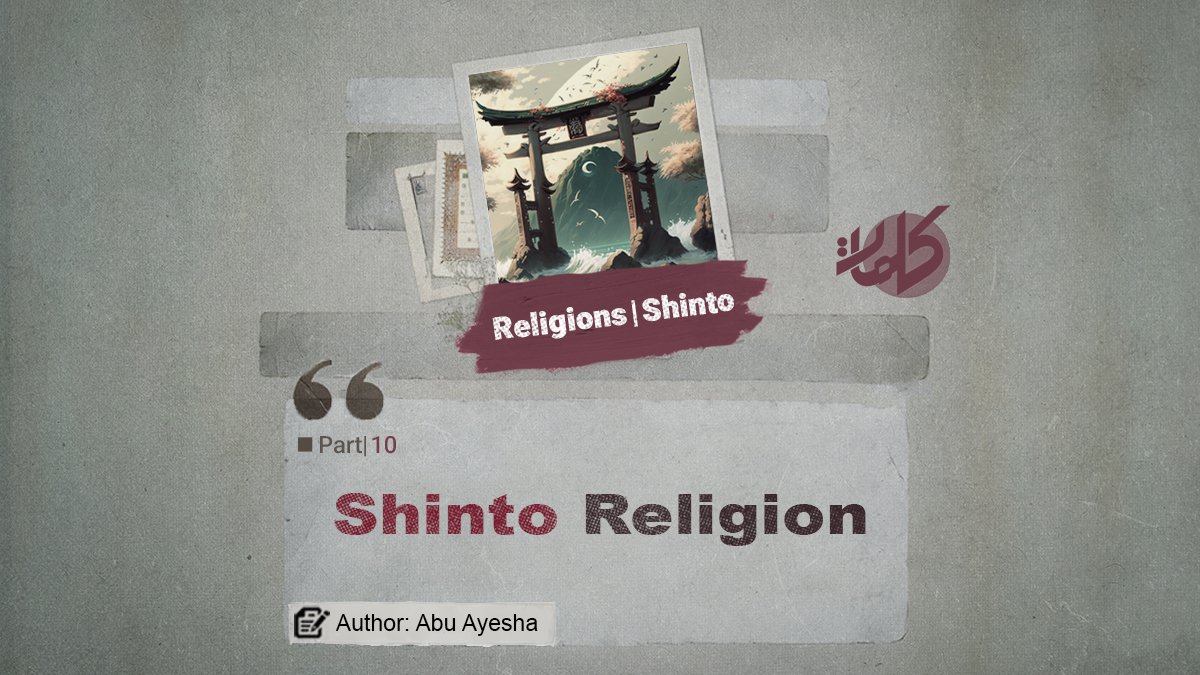Author: Abu Ayesha
Shinto Religion (Part 10)
Shinto Shrines in the Present Era
In 1945, when one hundred and ten thousand Shinto shrines and altars, which until that date had been under the direct supervision of the Ministry of Home Affairs (Japan), gained freedom and independence and their subsidies were cut off, a certain amount of disorder and disruption appeared in their administration. For a while, the priests—who until then had directly managed the affairs—remained confused and uncertain. However, it was not long before the situation stabilized and regained organizational order. Shinto shrines took on the form of a national religion, and public attention and visits to these shrines once again became customary. Many of them were repaired and restored, and national and local associations were formed everywhere to preserve and support the shrines. New sources of income were gathered through offerings and donations until eighty-six thousand Shinto shrines came under the protection of national associations throughout the country, their activities resumed, and they once more gained the care and attention of the people.[1]
In every village, a special shrine was built, situated among lush green trees and evergreen bushes, providing a beautiful view. Each shrine was constructed with a rectangular courtyard surrounded by sacred plants, with a famous Shinto gate, “Torii,” at the central entrance. These gates, like the minarets of Islamic mosques or the conical pagodas of Buddhists, are considered sacred and prominent structures. Devoted pilgrims pass through them, walk along paths shaded by sacred trees, and enter the central shrine. Inside lies a delicate and beautiful structure with a small bell hanging beneath a projecting canopy. When a pilgrim arrives, after washing hands and mouth, he removes his hat and outer garment, joins his hands in the Japanese style of supplication, bows, rings the bell, lowers his head in deep humility, places an offering wrapped in cloth in the designated box, prays, then bows again. He then remains silent in meditation and reverence. After a short while, he quietly leaves, and upon reaching the gate, turns back, bows once more, and departs.[2]
In the same compound, in a place near the inner shrine connected by a roofed corridor, lies the sacred treasury known as the “Honden.” Visitors are usually not allowed to enter, but everyone in the village or district knows that the most sacred object of the shrine is hidden there. This sacred object is called Shintai, meaning “noble body.” It is rarely displayed, except on special occasions. Although it has no material value, it is usually a small item wrapped in silk and placed inside several nested boxes. It may be an old sword, an ancient dagger, a piece of mirror, a crystal vessel, or a parchment scroll inscribed with words. This sacred object has always been revered by the local people and tribal elders as a legacy of their ancestors. It symbolizes a supreme supernatural power. Once a year, during the annual festival, the people place it on a sacred cart and parade it through the streets. Flags and banners are carried ahead, while musicians and heralds wearing strange masks follow, and beautiful young girls dance to the music of drums and flutes.[3]
Below are some of the most famous Shinto shrines:
-
Fushimi Inari Taisha Shrine
This Shinto shrine is dedicated to the god of rice, Inari. It is famous for its thousands of red gates (torii) that create a beautiful path through the forest leading to the sacred shrine.[4]
There are various accounts about the exact date of construction of Fushimi Inari. Since its sections were not built all at once, many traditions exist. However, it is widely said that the shrine was built during the Heian period (794–1185 CE), the final stage of ancient Japan before the feudal era. Fushimi Inari gained great popularity between 1871 and 1946, during which it was officially recognized as one of Japan’s most important shrines. Some traditions say that in 816 CE, the exact location of the original shrine was chosen by the eminent monk Kukai, who desired such a shrine to be built in Fushimi.[5]
-
Meiji Shrine (Meiji-go)
One of the first modern emperors who turned Japan into a major world power was Emperor Meiji. He was so beloved in Japan that a shrine was built in memory of him and his wife. During the New Year, this shrine welcomes over three million visitors for the Hatsumode prayers, and throughout the year it often hosts traditional Shinto weddings.[6]
-
Hida Sanno Shrine
Located in Takayama, this important Shinto shrine is known for its unique and beautiful Japanese architecture. Every year, the famous Sanno Matsuri festival is held here, attracting many tourists from across Japan.[7]
-
Yasaka Shrine
One of the most beautiful Shinto shrines in Kyoto[8], Yasaka Shrine, is also known as the Gion Shrine. It is the center of the annual Gion Festival. Built in the 7th century, it is dedicated to the Shinto god Susanoo-no-Mikoto, symbolizing prosperity and protection against calamities. A popular practice here is to write prayers or wishes on small pieces of paper and tie them to a tree covered with paper bows.[9]
-
Kamigamo Jinja Shrine
-
Matsuo Taisha Shrine
-
Kitano Tenmangu Shrine
-
Shimmi Kyoto Shrine
The Torii Gate
One of the most revered and famous elements in the Shinto faith is the Torii gate. This gate holds great importance among the Japanese, who regard it as the entrance to their shrines. The number of Torii gates varies from shrine to shrine; some have many, others fewer.
Torii gates mark the entrances of Shinto shrines. Believers consider them the boundary between this world and the realm of the gods. The Torii allows auspicious spirits to enter while keeping away evil spirits and demons. They are usually painted red and made of wood or stone. When Japanese people pass through a Torii, they usually bow. They are advised to walk along the sides of the pathway, since the center, often covered with pebbles, is reserved for the passage of the Kami (deities).[10]
Note 1
As mentioned earlier, the number of Shinto shrines where people worship and perform rituals is extremely large. We did not intend to describe all of them here, for such an effort would require volumes of writing and would not necessarily benefit readers. For instance, in the city of Kyoto alone, there are about 400 Shinto shrines: “Kyoto, an ancient city with a long history, has more than 400 Shinto shrines.”[11] In this study, we only aimed to briefly introduce some of the most important and famous shrines.
Note 2
The purpose of presenting Shinto shrines and temples here is to provide readers with a better understanding of this faith, showing where and how worship takes place. The aim is not to promote tourism for Japan. Shrines in every religion play an essential role in awakening people, fostering intimacy, affection, and community bonds. For example, in Islam, mosques were the foundations of the Islamic government, where organized plans for da‘wah, jihad, and other aspects of life were made. For this reason, we have studied Shinto shrines to understand their role in people’s lives and their connection to them.
One author writes: “These days, Shinto shrines play a significant role in supporting social welfare and charitable associations in the regions where they exist, a factor that strengthens the belief in Kami.”[12]
Continues…
Previous Part / Next Part
References:
[1] John Noss, A History of the World’s Religions, trans. Ali Asghar Hekmat, 3rd ed., 1975 (1354 AH Solar), Franklin Publications, p. 291.
[2] Ibid., p. 292.
[3] John Noss, A History of the World’s Religions, trans. Ali Asghar Hekmat, 3rd ed., 1975 (1354 AH Solar), Franklin Publications, p. 292.
[4] Sara Ashraf Nejad, Setareh Vank Website, “Introduction to the 30 Most Remarkable Shrines of Japan,” 2024.
[5] Daruma Website, author: Tsubaki, “Introduction to Fushimi Inari Shrine, Kyoto,” 2018 (1397 AH Solar).
[6] Sara Ashraf Nejad, Setareh Vank Website, “Introduction to the 30 Most Remarkable Shrines of Japan,” 2024.
[7] Raghieh Naqavi, “The Most Famous Shrines of Japan,” Pool Bank Website, 2022 (1401 AH Solar).
[8] Kyoto is one of Japan’s major historic cities, with about 1.5 million inhabitants. It served as the capital for 1,100 years and was the residence of Japanese emperors.
[9] Zhivar Website, “Shinto Shrines: The Most Beautiful Shinto Shrines in Kyoto,” 2022 (1401 AH Solar).
[10] Society and Culture of Nations Analytical Website, “A Look at Shinto and Buddhism: Two Popular Religions in Japan,” 2021 (1400 AH Solar).
[11] Zhivar Website, “Shinto Shrines: The Most Beautiful Shinto Shrines in Kyoto,” 2022 (1401 AH Solar).
[12] Iman Badi‘ Abd Rabbih, Al-Islam fi al-Yābān, n.d., p. 12.



